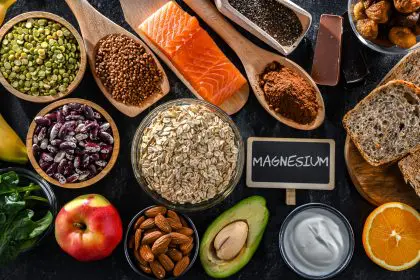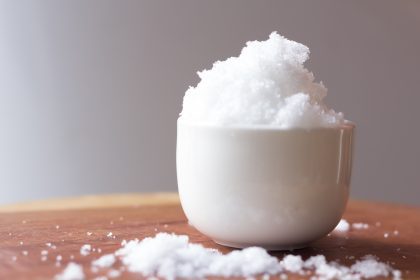When muscle pain strikes, many reach for over-the-counter pain relievers without considering what might be missing from their body. Magnesium, an essential mineral involved in hundreds of biochemical reactions, could be the missing link for those suffering from persistent muscle discomfort. This powerhouse nutrient works through multiple mechanisms to soothe aching muscles while supporting overall health in ways that might surprise you.
The hidden connection between magnesium and muscle function
Your muscles rely on magnesium for their most basic functions. This mineral enables the energy production needed for muscle contraction and relaxation, making it vital for everyday movement. When levels fall below optimal, muscles struggle to complete this natural cycle, often resulting in persistent tension, spasms, and pain that can disrupt sleep and daily activities.
Magnesium also regulates calcium flow within muscle cells, maintaining the delicate balance needed for proper function. Without adequate magnesium, calcium can flood muscle cells, causing them to remain in a contracted state rather than relaxing properly. This prolonged contraction leads to the stiffness and soreness many experience after exercise or during periods of stress.
How magnesium works to eliminate muscle pain
Magnesium tackles muscle discomfort through several distinct pathways. First, it acts as a natural calcium blocker at the cellular level, ensuring muscles can fully relax after contracting. This relaxation phase is essential for preventing cramps and spasms that can strike suddenly and painfully.
The mineral also plays a crucial role in energy metabolism. Each muscle cell contains mitochondria—tiny powerhouses that produce ATP, the energy currency needed for all cellular functions. Magnesium activates ATP, making it usable by muscle cells. Without sufficient magnesium, energy production falters, and muscles tire more easily, leading to increased pain sensitivity.
Inflammation reduction represents another key mechanism through which magnesium relieves discomfort. Chronic low-grade inflammation can sensitize nerve endings in muscle tissue, amplifying pain signals. Magnesium helps dampen this inflammatory response, potentially reducing pain perception and supporting faster recovery from exertion.
Magnesium also helps regulate neurotransmitters that influence pain perception. It blocks N-methyl-D-aspartate (NMDA) receptors in the brain, which are involved in pain signal transmission and central sensitization—the process where the nervous system becomes increasingly responsive to pain. This modulation can help decrease pain intensity for those with chronic muscle issues.
Beyond muscle relief: additional benefits of optimal magnesium levels
While muscle function may be the most noticeable benefit, adequate magnesium levels support multiple body systems. Blood pressure regulation improves with sufficient magnesium, as the mineral helps relax blood vessel walls, allowing easier blood flow and reducing strain on the cardiovascular system.
Bone health depends heavily on magnesium, which helps activate vitamin D and regulate calcium—both essential for maintaining bone density. This makes magnesium particularly important for preventing age-related bone loss that can lead to fractures.
Many experience improvements in sleep quality when magnesium levels are optimized. The mineral helps regulate the body’s stress-response system and calms the nervous system, potentially allowing for deeper, more restorative sleep that further supports muscle recovery and pain reduction.
Some research suggests regular magnesium intake may help reduce migraine frequency and intensity. Since many migraine sufferers also experience muscle tension, especially in the neck and shoulders, addressing magnesium status might provide dual benefits for these overlapping conditions.
The most effective magnesium-rich foods for muscle support
Incorporating magnesium-rich foods into your daily diet provides a sustainable approach to maintaining optimal levels. Dark leafy greens like spinach contain approximately 78 mg per half-cup serving, providing 19% of the daily requirement while delivering additional nutrients that support muscle health.
Seeds offer concentrated magnesium sources perfect for snacking or meal additions. Pumpkin seeds contain an impressive 156 mg per ounce, fulfilling 37% of daily needs. Chia seeds provide 111 mg per ounce, making them another excellent option easily added to smoothies, yogurt, or breakfast cereals.
Whole grains contribute significant magnesium while providing sustained energy for active muscles. Brown rice contains 42 mg per half-cup serving, representing 10% of daily requirements. Quinoa offers similar amounts while providing complete protein to support muscle repair.
Legumes deliver magnesium alongside protein, creating an ideal combination for muscle health. Black beans contain approximately 60 mg per half-cup serving, while chickpeas offer similar amounts. These versatile foods can be incorporated into numerous dishes from soups to salads.
Nuts provide portable magnesium sources perfect for on-the-go nutrition. Almonds offer approximately 80 mg per ounce, while cashews contain about 75 mg per ounce. A small handful makes an ideal post-workout snack to support muscle recovery.
Non-dairy milk alternatives often contain significant magnesium, with soymilk providing 61 mg per cup, representing 15% of daily needs. These can be used in smoothies, coffee, or cooking as an easy way to boost magnesium intake throughout the day.
Avocados deliver approximately 58 mg of magnesium per medium fruit while providing healthy fats that support nutrient absorption and reduce inflammation, creating a powerful combination for muscle health and pain management.
Supplement options: finding the right magnesium for your needs
When dietary sources prove insufficient, supplements offer targeted approaches to address magnesium deficiency and muscle pain. Various forms exist, each with unique properties and absorption rates that may benefit different individuals.
Magnesium citrate features excellent bioavailability, making it effective for overall magnesium repletion and muscle relaxation. This form dissolves well in water, creating a solution that can be easily consumed. Its gentle laxative effect makes it less suitable for those with sensitive digestion.
Magnesium glycinate represents one of the most bioavailable and gentle forms, making it ideal for those with sensitive digestive systems. The glycine component provides additional calming effects that may enhance sleep quality while reducing muscle tension.
Magnesium malate combines magnesium with malic acid, which plays a role in energy production. This form may be particularly beneficial for those experiencing muscle fatigue alongside pain, as it supports the energy cycles within muscle cells that prevent excessive fatigue.
Magnesium threonate uniquely crosses the blood-brain barrier more effectively than other forms, potentially offering enhanced benefits for the central nervous system aspects of pain perception. This newer form shows promise for addressing the neurological components of chronic muscle discomfort.
Magnesium chloride typically appears in topical preparations that bypass the digestive system entirely. These products allow the mineral to absorb directly through the skin into underlying muscle tissue, providing targeted relief without systemic side effects.
Magnesium sulfate, commonly known as Epsom salt, has been used for generations in bath soaks to relieve muscle tension and soreness. While absorption through the skin remains somewhat controversial scientifically, many find significant subjective relief from these baths.
Topical applications: direct relief for problem areas
For immediate, targeted muscle pain relief, topical magnesium products offer distinct advantages. These preparations typically contain magnesium chloride in concentrations designed to penetrate skin and affect underlying muscle tissue directly.
Magnesium oils actually consist of a saturated solution of magnesium chloride that feels slick like oil when applied to skin. These concentrated products can be sprayed or rubbed directly onto painful areas, where the mineral begins absorbing immediately. Some users report a tingling sensation during application that diminishes with regular use.
Magnesium creams and lotions combine the mineral with moisturizing ingredients that improve the application experience while facilitating absorption. These formulations often include additional pain-relieving ingredients like arnica or menthol for enhanced effect.
Magnesium bath flakes dissolve in warm water, creating a full-body soaking experience that targets multiple muscle groups simultaneously. The warm water enhances relaxation while opening pores for improved mineral absorption across the body’s largest organ—the skin.
Creating your personal magnesium protocol for pain relief
Developing an effective magnesium strategy requires personalization based on your specific pain patterns, lifestyle factors, and body responses. Begin by increasing magnesium-rich foods in your daily diet, aiming for consistency rather than occasional large amounts.
For supplementation, start with lower doses and gradually increase to avoid digestive discomfort. Most adults tolerate 200-350mg initially, with some eventually benefiting from higher amounts under appropriate supervision. Taking supplements with food typically improves tolerance and absorption.
Timing matters when using magnesium for muscle pain. Taking supplements approximately 1-2 hours before bedtime can help relax muscles during sleep while potentially improving sleep quality. For active individuals, an additional dose after exercise may support recovery.
Topical applications work best when applied to clean, slightly damp skin to facilitate absorption. These can be used as needed for acute pain episodes or incorporated into a daily routine for chronic issues, particularly for targeted areas that consistently cause problems.
For optimal results, combine multiple approaches. Many find the most significant improvement using dietary sources as foundation, oral supplements for systemic effects, and topical applications for immediate relief of specific painful areas.
Understanding potential limitations and cautions
While generally safe for most individuals, excessive magnesium intake can cause digestive disturbances including loose stools, cramping, and nausea. These symptoms typically indicate a need to reduce oral dosage or switch to a more easily tolerated form.
Those with kidney disease should consult healthcare providers before supplementing, as compromised kidney function can affect magnesium elimination from the body, potentially leading to unsafe accumulation over time.
Certain medications interact with magnesium, including antibiotics, diuretics, and osteoporosis medications. Maintaining appropriate timing between these medications and magnesium supplements helps prevent interference with absorption or effectiveness.
Monitoring your body’s response provides the best guidance for personalization. Improvements in muscle comfort, sleep quality, and energy levels typically indicate beneficial effects, while digestive changes may suggest a need for adjustment.
Beyond supplements: lifestyle factors that affect magnesium status
Optimizing magnesium involves more than just consumption—various lifestyle factors significantly impact how your body utilizes this crucial mineral. Chronic stress depletes magnesium reserves rapidly, as the body uses the mineral during stress responses. Incorporating stress management techniques helps preserve magnesium levels during challenging periods.
Hydration status directly affects mineral balance including magnesium. Adequate water intake ensures proper cellular function and nutrient delivery to muscle tissues. Aim for consistent hydration throughout the day rather than large amounts periodically.
Excessive alcohol consumption increases magnesium excretion while impairing absorption. Moderating intake helps maintain optimal levels for muscle function and pain management. Similarly, high caffeine consumption can increase magnesium excretion through urine, potentially contributing to deficiencies over time.
Regular physical activity offers a double-edged relationship with magnesium. While exercise increases immediate magnesium requirements and losses through sweat, consistent activity improves nutrient utilization and muscle function long-term, ultimately supporting better magnesium efficiency within the body.
Incorporating these lifestyle considerations alongside dietary and supplement strategies creates a comprehensive approach to magnesium optimization that effectively addresses muscle pain while supporting overall health and wellness.

















